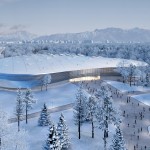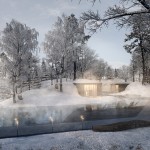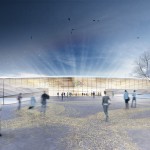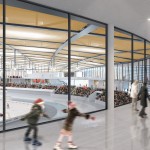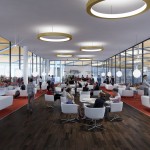Schulitz Architects was one of the three finalists in the international competition for the 2022 Winter Olympics ice skating complex in Beijing, China, which comprises a 400 m speed skating track and additional ice skating areas.
In the proposed design, the Olympic Park’s existing landscape of hills and winding paths is extended to situate the new sports facility. It is located on an elevated podium within this hilly park landscape clearly visible from the surrounding areas. The landscape’s generous gestures welcome and invite the visitors, and accompany them inside the arena. The building complex combined with the surrounding landscape evolve to a place of individual identity and offer great opportunities for everyone. The distinctive triangular form derives from the inner organization, resulting in an iconic building, a new heart for Beijing’s Olympic Park.
The 400 m ice oval with its 12,000 spectators as the main Olympic venue is augmented by an additional ice hockey field and the new main attraction after the Olympic Games: an elevated ice skating track. The new elevated ice rink gives the public the opportunity to experience ice skating on a new level, promoting China’s “300 Million People Playing Sports on Ice and Snow” program. The ice skating track offers fantastic views of the inside and of the surrounding landscapes and landmarks.
A restaurant area on the top level with views into the Olympic ice oval, ice hockey rink and the elevated ice skating track complements the experience.
The design of the roof and facade follows sustainable aspects according to LEED Gold certification standards: The external horizontal louvre system illuminates the interior without allowing direct sunlight to enter. At the same time, the visitors on the elevated ice skating track have the opportunity to experience the views of the outside landscape. The roof’s skylights are oriented to the north, illuminating the ice oval and auxiliary hall with indirect sunlight. Solar panels on the skylights provide electricity.
At night, the building is lit up with LED technology, allowing the building to glow in various colourful moods according to the current event.
The design’s optimized flexibility of use, the ondulating landscape design, the highly efficient building envelope and its implementation in the urban context resulted in a top prize in the international competition.
